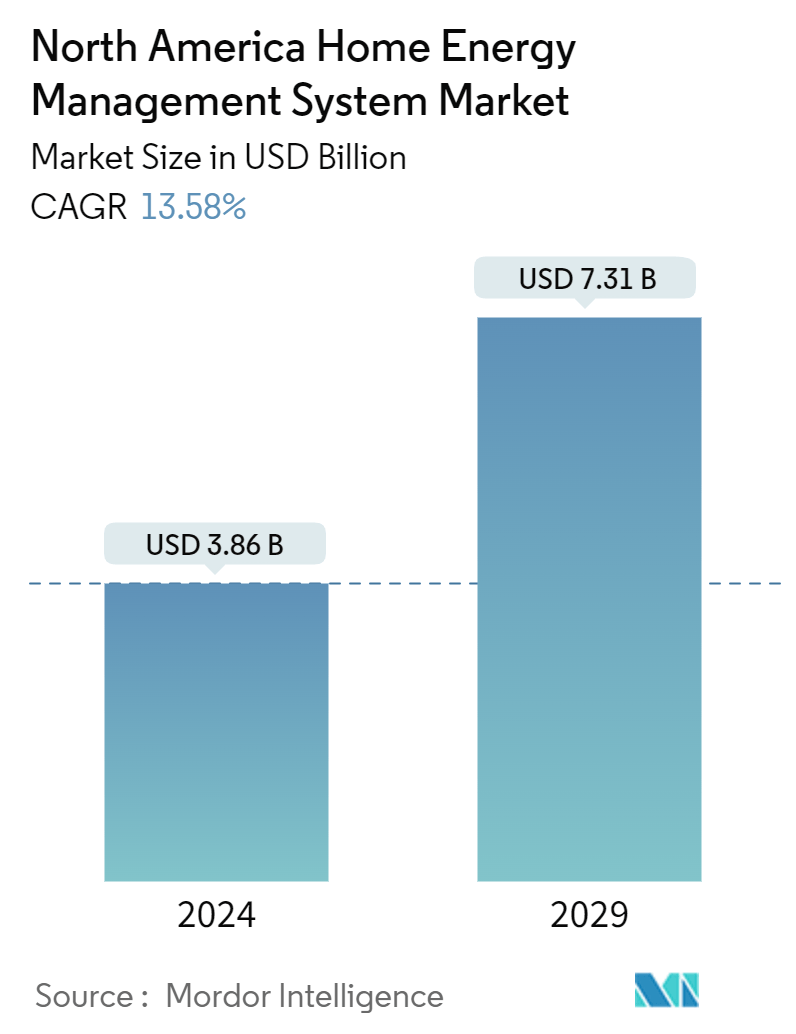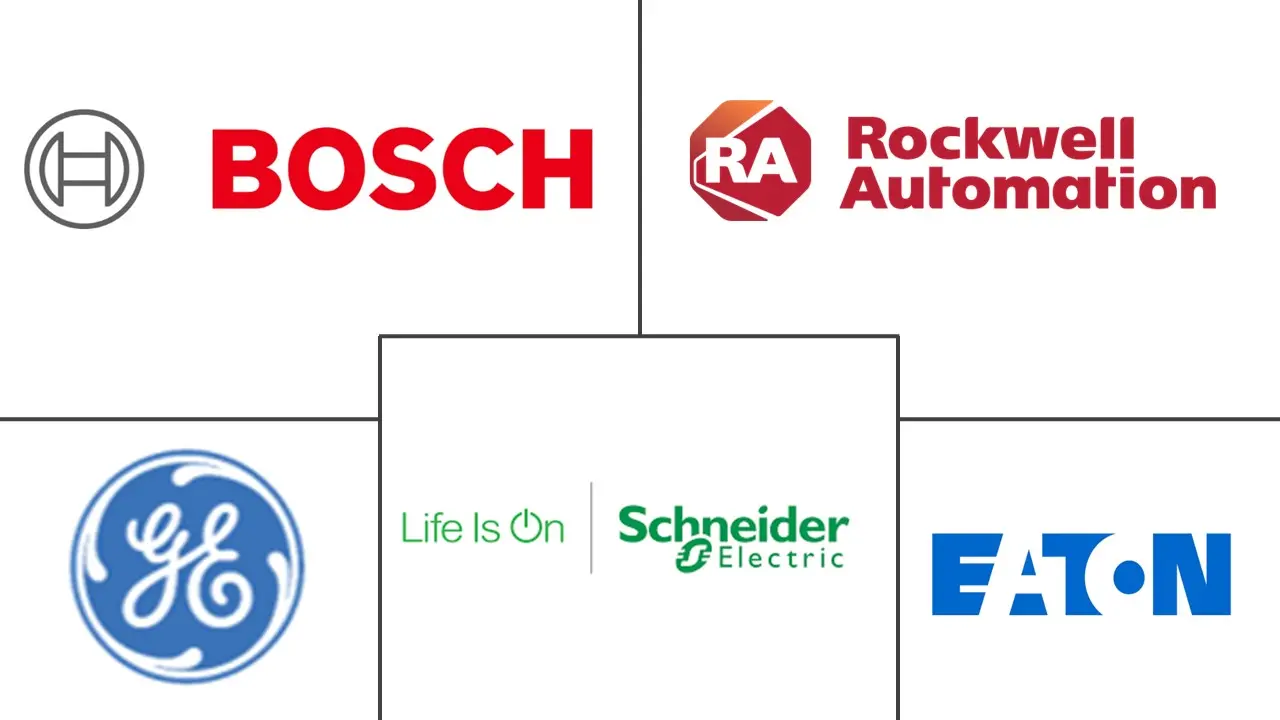Market Size of North America Home Energy Management System Industry

| Study Period | 2019 - 2029 |
| Base Year For Estimation | 2023 |
| Market Size (2024) | USD 3.86 Billion |
| Market Size (2029) | USD 7.31 Billion |
| CAGR (2024 - 2029) | 13.58 % |
| Market Concentration | Low |
Major Players
*Disclaimer: Major Players sorted in no particular order |
North America Home Energy Management System Market Analysis
The North America Home Energy Management System Market size is estimated at USD 3.86 billion in 2024, and is expected to reach USD 7.31 billion by 2029, growing at a CAGR of 13.58% during the forecast period (2024-2029).
A home energy management system (HEMS) combines hardware and software components to manage home energy usage efficiently. Compatible appliances can also be connected to a HEMS, allowing the user to control when appliances operate, including manually turning appliances off or on and setting up scheduled running times.
- Smart home technology has been gaining increasing popularity in recent years. A survey by Cinch Home Services during the second wave of the COVID-19 pandemic found that 77% of the respondents embraced the concept of smart home technology overall and had a positive sentiment. Smart home technologies present consumers with new ways to control and interact with their environments and unlock new opportunities for managing energy savings. Smart home solutions also continue to grow and have the potential to be more interconnected with HEMS systems within individual homes.
- There is a rapid transition towards smart grids due to the continuously growing electricity consumption and the need to provide a secure and sustainable power supply. Energy management systems are a vital part of the smart grids as they help to improve renewable energy consumption and energy efficiency. EMS is used to regulate and manage electric power so that it operates at its best. Utilizing a variety of sensors to obtain information in EMS may enhance the protection and safety of power infrastructure.
- The growing demand for energy across North America drives the investment in energy-efficient devices. For instance, as per the US Department of Energy, heating and cooling account for about 50% of a typical home’s energy usage, which makes high-performance energy management systems such as HVAC controllers, Programmable Communicating Thermostats, Advanced Central Controllers systems critical to managing energy consumption and costs for homeowners as well as cumulatively across the nation.
- Installing a fully automated, state-of-the-art Energy Management System (EMMS) in a building comes with significant upfront costs. As homeowners want to reduce their energy consumption, they require energy management systems that track the energy consumption of various devices. The use of energy-efficient solutions and practices leads to substantial long-term cost savings and energy savings. However, it requires a large upfront investment, slowing down the adoption.
- The impact of current macroeconomic factors on the automation sector is a complex and dynamic issue that can affect economic growth and labor productivity. Rise in inflation may result in higher production costs, impacting the adoption of smart sensors. As governments combat inflation by increasing interest rates, new job creation would slow down and impact economic activity and growth.
North America Home Energy Management System Industry Segmentation
A home energy management system (HEMS) is a digital system that monitors and controls household energy generation, storage, and consumption. HEMS usually optimizes for a purpose such as cost reduction, self-sufficiency maximization, or emissions depreciation. HEMS is evolving and gaining more popularity with the rise in adoption of electric mobility and heating, residential PV, and dynamic tariffs, as it increases the saving potential.
The North American home energy management system market is segmented by component (hardware, software, and services), product type (lighting controls, self-monitoring systems and services, programmable communicating thermostats, advanced central controllers, and intelligent HVAC controllers), technology (ZigBee, Wi-Fi, internet, Z-Wave, and other technologies), and country (United States, and Canada). The report offers market forecasts and size in value (USD) for all the above segments.
| By Component | |
| Hardware | |
| Software | |
| Services |
| By Product Type | |
| Lighting Controls | |
| Self-Monitoring Systems and Services | |
| Programmable Communicating Thermostats | |
| Advanced Central Controllers | |
| Intelligent HVAC Controllers |
| By Technology | |
| ZigBee | |
| Wi-Fi | |
| Internet | |
| Z-Wave | |
| Other Technologies |
| By Country | |
| United States | |
| Canada |
North America Home Energy Management System Market Size Summary
The North American home energy management system market is poised for significant growth, driven by the increasing adoption of smart home technologies and the need for energy efficiency. Home energy management systems (HEMS) integrate hardware and software to optimize energy usage in residential settings, allowing users to control and schedule appliance operations. The market is experiencing a surge in demand due to the rapid transition towards smart grids, which require efficient energy management solutions to handle growing electricity consumption and enhance renewable energy integration. The rise in urbanization and the shift towards smart urban lifestyles further propel the market, as more households seek to implement smart devices and technologies that minimize energy wastage.
The market landscape is characterized by a fragmented structure with key players like Robert Bosch GMBH, Rockwell Automation Inc., General Electric Company, Schneider Electric SE, and Eaton Corporation PLC actively participating. These companies are leveraging strategies such as partnerships and acquisitions to strengthen their market position and expand their product offerings. Government initiatives, such as tax credits and incentives for energy-efficient home modifications, are expected to bolster market growth by encouraging the installation of HEMS. Additionally, advancements in IoT and sensing technologies are enhancing the capabilities of energy management systems, contributing to their increasing adoption across North American households.
North America Home Energy Management System Market Size - Table of Contents
-
1. MARKET INSIGHTS
-
1.1 Market Overview
-
1.2 Industry Attractiveness - Porter's Five Forces Analysis
-
1.2.1 Bargaining Power of Suppliers
-
1.2.2 Bargaining Power of Buyers
-
1.2.3 Threat of New Entrants
-
1.2.4 Threat of Substitute Products and Services
-
1.2.5 Intensity of Competitive Rivalry
-
-
1.3 Industry Value Chain Analysis
-
1.4 Impact of COVID-19 After-effects and Other Macroeconomic Factors on the Market
-
-
2. MARKET SEGMENTATION
-
2.1 By Component
-
2.1.1 Hardware
-
2.1.2 Software
-
2.1.3 Services
-
-
2.2 By Product Type
-
2.2.1 Lighting Controls
-
2.2.2 Self-Monitoring Systems and Services
-
2.2.3 Programmable Communicating Thermostats
-
2.2.4 Advanced Central Controllers
-
2.2.5 Intelligent HVAC Controllers
-
-
2.3 By Technology
-
2.3.1 ZigBee
-
2.3.2 Wi-Fi
-
2.3.3 Internet
-
2.3.4 Z-Wave
-
2.3.5 Other Technologies
-
-
2.4 By Country
-
2.4.1 United States
-
2.4.2 Canada
-
-
North America Home Energy Management System Market Size FAQs
How big is the North America Home Energy Management System Market?
The North America Home Energy Management System Market size is expected to reach USD 3.86 billion in 2024 and grow at a CAGR of 13.58% to reach USD 7.31 billion by 2029.
What is the current North America Home Energy Management System Market size?
In 2024, the North America Home Energy Management System Market size is expected to reach USD 3.86 billion.

